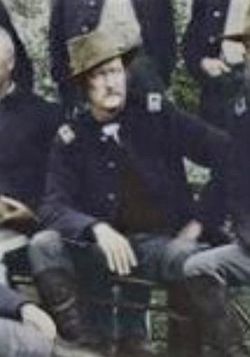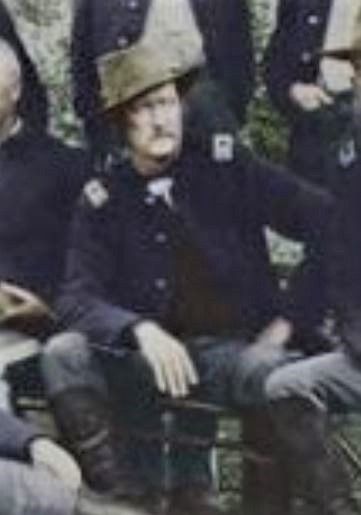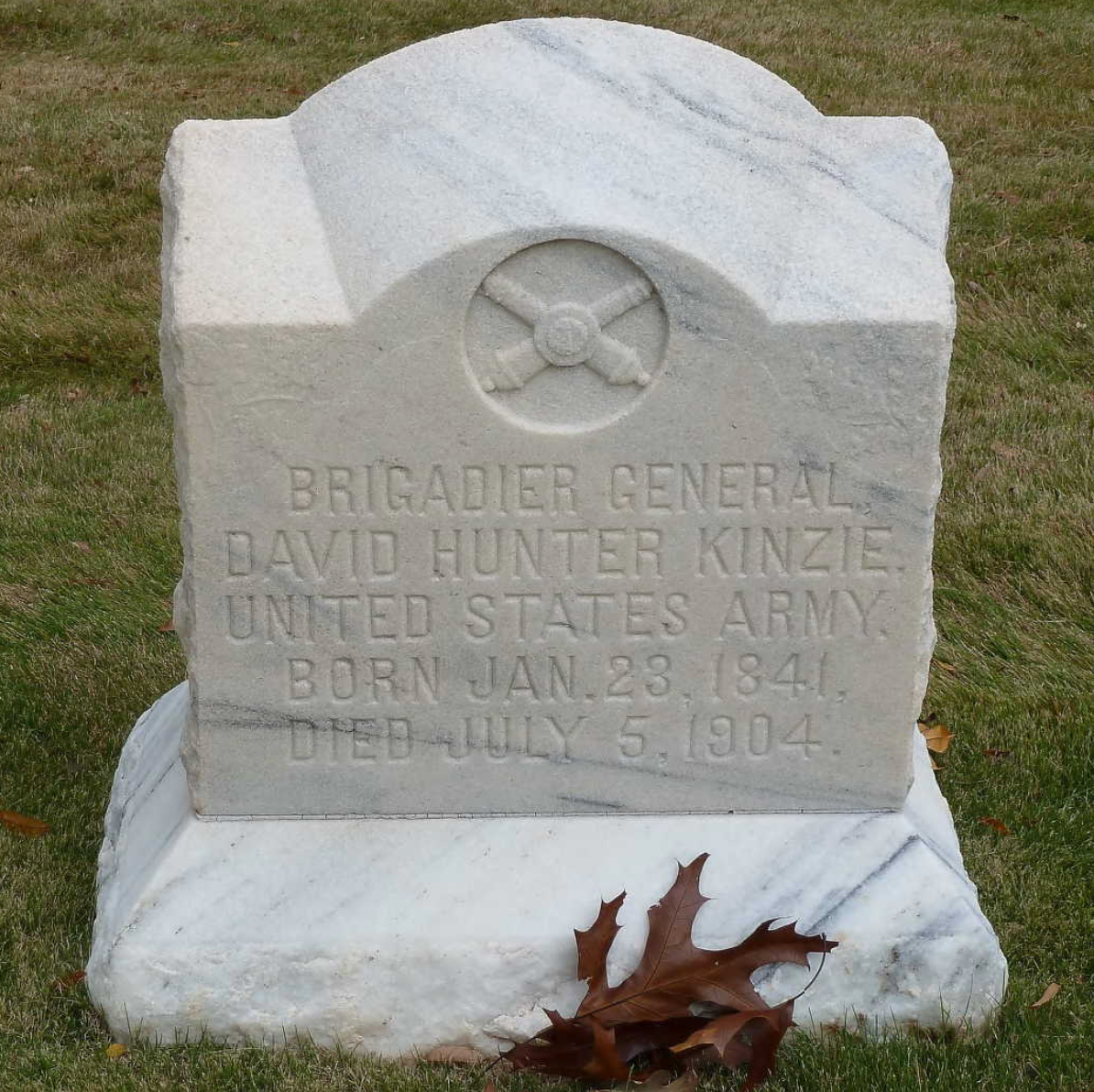David Hunter Kinzie was accepted to the United States Military Academy at West Point, New York in 1859. He attended for two years until the outbreak of the Civil War in 1861, at which time he left the academy and applied for a commission in the United States Army. Kinzie was commissioned a second lieutenant in the newly-established 5th Regiment of United States Artillery on May 14, 1861, attached to Battery K.
Kinzie had the distinction of being present at most of the major battles of the Eastern Theater of the Civil War:
Lieutenant Kinzie's company was attached to the Union Army of the Potomac when it embarked upon Major General George B. McClellan's Peninsula Campaign against the Confederate capital of Richmond, Virginia in March 1862. After the siege of Yorktown, while the army was mere miles from the Confederate city, it was struck by a counteroffensive campaign made by the new rebel field commander, General Robert E. Lee. Though outnumbered in the field, it was Lee's belief that if he could strike the Union Army hard and fast enough, he could break McClellan's confidence and force a retreat. The resulting Seven Days Battles of June/July 1862 saw some of the fiercest fighting of the war.
As the Army of the Potomac moved south from the Chickahominy River near Richmond toward a stronger defensive position to the south, it was perilously vulnerable to attack in transit. On June 30, 1862, with the Army spread out for miles across the peninsula, Lee's forces thrust at its flank to attempt to divide and destroy it. While the main body was engaged near Glendale on June 30, 1862, Lieutenant Kinzie's company was part of the Union force attempting to safeguard the Union Army's rear from being outflanked from behind. When Confederate Major General Thomas "Stonewall" Jackson's forces arrived to try to roll up the force from the north, Union artillerists successfully suppressed them with punishing artillery fire, keeping them north of the White Oak Bridge--for his actions at this Battle of White Oak Swamp, Lieutenant Kinzie earned a brevet promotion to the rank of first lieutenant for gallant and meritorious service in action.
Following the termination of the Peninsula Campaign, Battery K, 5th U.S. accompanied the Union V Corps to join Major General John Pope's campaign near Manassas, Virginia--resultingly, it was engaged at the Second Battle of Bull Run, where its commander, Captain John Smead, was killed in action. Kinzie received a Regular Army promotion to the rank of first lieutenant on August 30, 1862, the final day of the fight.
In September 1862, Battery K was engaged at the Battle of Antietam, where Kinzie earned a brevet promotion to the rank of captain for gallant and meritorious service in action.
By December 1862, Brevet Captain Kinzie was acting-commander of Battery K, 5th U.S., leading it during the Battles of Fredericksburg in December 1862, the Battle of Chancellorsville in May 1863, and the Battle of Gettysburg in July 1863, where he led his battery in a fierce counterbattery duel with rebel gunners from Culp's Hill on the second day of fighting, and was exposed to heavy artillery fire overshooting Cemetery Ridge during the Confederate barrage prior to Pickett's Charge on the third day.
In September 1863, Battery K, 5th U.S. was transferred to the Western Theater, joining the XII Corps of the Army of the Cumberland in Tennessee. It was present during the Chattanooga Campaign and throughout the siege of Atlanta, Georgia.
At the close of the war, Kinzie was awarded a final brevet promotion to the rank of major for good conduct and gallant service during the war.
Post war, Kinzie remained in the 5th U.S. Artillery; he declined a promotion to captain of an infantry regiment in 1866, electing to stay with the artillery as a lieutenant until he was finally promoted to captain of Battery E, 5th U.S. in 1871. He remained in command at various East Coast installations until 1886, when he was transferred to Battery D, 5th U.S. and sent west. With Battery D, Kinzie served on frontier duty at Fort Douglas, Utah and the Presidio at San Francisco, California.
In October 1894, Kinzie was promoted to the rank of major with the 1st U.S. Artillery, but soon returned to his familiar 5th U.S. He was the commanding officer of Fort Canby, Washington on the mouth of the Columbia River and was later, upon transferring to the 3rd U.S. Artillery, commander of the harbor defenses of San Francisco, California while stationed at Fort Point in 1898.
Kinzie was promoted to the rank of lieutenant colonel with the 1st U.S. Artillery in February 1899, finally returning east to Jackson Barracks, Louisiana. Following the restructuring of the artillery regiments into the United States Army Artillery Corps in 1901, Kinzie was promoted to the rank of colonel; in 1902, he assumed command of the Military District of Baltimore, Maryland from headquarters at Fort McHenry.
After more than forty years of service, Colonel Kinzie announced his retirement, to take effect in August 1903. As was fairly customary at the time, he was awarded the rank of brigadier general on August 10, 1903, a single day before his retirement from the United States Army on August 11, 1903.
Regrettably, his retirement did not last long. Kinzie suffered what was likely a major stroke in November 1903. His health generally impaired, Kinzie and his wife went to live with their daughter and son-in-law near Atlanta, Georgia, where General Kinzie's health gradually declined until his death in July 1904 at the age of 63.
David Kinzie was a bachelor until the age of 30, when he married Elvenah Janes; this was a somewhat unusual match, as "Ellie" was the widow of his first cousin, John Kinzie, who had been killed almost ten years earlier aboard the Union ironclad USS Mound City during the Civil War in 1862. At the time of their marriage in 1871, she had an eight-year-old daughter, Laura, from her first marriage. (The arrangement seemed well-advised for David, as there is some evidence of minor military disciplinary issues in his post-war career that appear to have been resolved entirely after he settled down with a family.) The Kinzies appeared to enjoy a happy marriage, and together they had six more children.
Brigadier General Kinzie's legacy as a distinguished artillery officer and Civil War veteran was honored by the United States Army in 1909, when it named an Endicott-era coast artillery seacoast defense battery at Fort Worden in Port Townsend, Washington "Battery David Kinzie" in his honor. (Ironically, Fort Worden was commanded at the time by Kinzie's first cousin, Colonel Garland Whistler.)
David Hunter Kinzie was accepted to the United States Military Academy at West Point, New York in 1859. He attended for two years until the outbreak of the Civil War in 1861, at which time he left the academy and applied for a commission in the United States Army. Kinzie was commissioned a second lieutenant in the newly-established 5th Regiment of United States Artillery on May 14, 1861, attached to Battery K.
Kinzie had the distinction of being present at most of the major battles of the Eastern Theater of the Civil War:
Lieutenant Kinzie's company was attached to the Union Army of the Potomac when it embarked upon Major General George B. McClellan's Peninsula Campaign against the Confederate capital of Richmond, Virginia in March 1862. After the siege of Yorktown, while the army was mere miles from the Confederate city, it was struck by a counteroffensive campaign made by the new rebel field commander, General Robert E. Lee. Though outnumbered in the field, it was Lee's belief that if he could strike the Union Army hard and fast enough, he could break McClellan's confidence and force a retreat. The resulting Seven Days Battles of June/July 1862 saw some of the fiercest fighting of the war.
As the Army of the Potomac moved south from the Chickahominy River near Richmond toward a stronger defensive position to the south, it was perilously vulnerable to attack in transit. On June 30, 1862, with the Army spread out for miles across the peninsula, Lee's forces thrust at its flank to attempt to divide and destroy it. While the main body was engaged near Glendale on June 30, 1862, Lieutenant Kinzie's company was part of the Union force attempting to safeguard the Union Army's rear from being outflanked from behind. When Confederate Major General Thomas "Stonewall" Jackson's forces arrived to try to roll up the force from the north, Union artillerists successfully suppressed them with punishing artillery fire, keeping them north of the White Oak Bridge--for his actions at this Battle of White Oak Swamp, Lieutenant Kinzie earned a brevet promotion to the rank of first lieutenant for gallant and meritorious service in action.
Following the termination of the Peninsula Campaign, Battery K, 5th U.S. accompanied the Union V Corps to join Major General John Pope's campaign near Manassas, Virginia--resultingly, it was engaged at the Second Battle of Bull Run, where its commander, Captain John Smead, was killed in action. Kinzie received a Regular Army promotion to the rank of first lieutenant on August 30, 1862, the final day of the fight.
In September 1862, Battery K was engaged at the Battle of Antietam, where Kinzie earned a brevet promotion to the rank of captain for gallant and meritorious service in action.
By December 1862, Brevet Captain Kinzie was acting-commander of Battery K, 5th U.S., leading it during the Battles of Fredericksburg in December 1862, the Battle of Chancellorsville in May 1863, and the Battle of Gettysburg in July 1863, where he led his battery in a fierce counterbattery duel with rebel gunners from Culp's Hill on the second day of fighting, and was exposed to heavy artillery fire overshooting Cemetery Ridge during the Confederate barrage prior to Pickett's Charge on the third day.
In September 1863, Battery K, 5th U.S. was transferred to the Western Theater, joining the XII Corps of the Army of the Cumberland in Tennessee. It was present during the Chattanooga Campaign and throughout the siege of Atlanta, Georgia.
At the close of the war, Kinzie was awarded a final brevet promotion to the rank of major for good conduct and gallant service during the war.
Post war, Kinzie remained in the 5th U.S. Artillery; he declined a promotion to captain of an infantry regiment in 1866, electing to stay with the artillery as a lieutenant until he was finally promoted to captain of Battery E, 5th U.S. in 1871. He remained in command at various East Coast installations until 1886, when he was transferred to Battery D, 5th U.S. and sent west. With Battery D, Kinzie served on frontier duty at Fort Douglas, Utah and the Presidio at San Francisco, California.
In October 1894, Kinzie was promoted to the rank of major with the 1st U.S. Artillery, but soon returned to his familiar 5th U.S. He was the commanding officer of Fort Canby, Washington on the mouth of the Columbia River and was later, upon transferring to the 3rd U.S. Artillery, commander of the harbor defenses of San Francisco, California while stationed at Fort Point in 1898.
Kinzie was promoted to the rank of lieutenant colonel with the 1st U.S. Artillery in February 1899, finally returning east to Jackson Barracks, Louisiana. Following the restructuring of the artillery regiments into the United States Army Artillery Corps in 1901, Kinzie was promoted to the rank of colonel; in 1902, he assumed command of the Military District of Baltimore, Maryland from headquarters at Fort McHenry.
After more than forty years of service, Colonel Kinzie announced his retirement, to take effect in August 1903. As was fairly customary at the time, he was awarded the rank of brigadier general on August 10, 1903, a single day before his retirement from the United States Army on August 11, 1903.
Regrettably, his retirement did not last long. Kinzie suffered what was likely a major stroke in November 1903. His health generally impaired, Kinzie and his wife went to live with their daughter and son-in-law near Atlanta, Georgia, where General Kinzie's health gradually declined until his death in July 1904 at the age of 63.
David Kinzie was a bachelor until the age of 30, when he married Elvenah Janes; this was a somewhat unusual match, as "Ellie" was the widow of his first cousin, John Kinzie, who had been killed almost ten years earlier aboard the Union ironclad USS Mound City during the Civil War in 1862. At the time of their marriage in 1871, she had an eight-year-old daughter, Laura, from her first marriage. (The arrangement seemed well-advised for David, as there is some evidence of minor military disciplinary issues in his post-war career that appear to have been resolved entirely after he settled down with a family.) The Kinzies appeared to enjoy a happy marriage, and together they had six more children.
Brigadier General Kinzie's legacy as a distinguished artillery officer and Civil War veteran was honored by the United States Army in 1909, when it named an Endicott-era coast artillery seacoast defense battery at Fort Worden in Port Townsend, Washington "Battery David Kinzie" in his honor. (Ironically, Fort Worden was commanded at the time by Kinzie's first cousin, Colonel Garland Whistler.)
Bio by: JP
Inscription
BRIGADIER GENERAL
UNITED STATES ARMY
Family Members
Advertisement


















